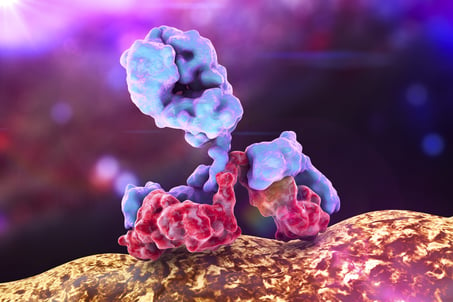Antigen selection and preparation
Optimal selection and preparation of the antigen is crucial to obtaining high-quality antibodies in both polyclonal and monoclonal antibody production. Although the importance of antigen selection and preparation is not immediately apparent to some in the field, Inotiv’s experience has shown that it is a critical consideration.
 The first step - selecting the antigen
The first step - selecting the antigen
The first step in this process is to select the antigen of interest. Features that require consideration include immunogenicity potential; many antigens are not highly immunogenic. Besides the issues with histocompatibility or self-antigens, the antigen type, source, purity, 3-D structure, and the intended final use of the antibody product are also important up front considerations. Since some applications are more suitable for polyclonal rather than monoclonal production or vice-versa, one of the first questions is therefore: “How do you intend to use your antibody?”
Preparing the antigen for immunization
After the appropriate antigen is selected, the next step is preparing the antigen for immunization and either selection of stimulated B cells or antibody collection. Because access to the native antigen is usually limited, recombinant protein expression is often used to produce sufficient quantities of antigen. This process may employ eukaryotic and/or prokaryotic expression systems.
Consideration when using eukaryotic expression is the possible impact on the proper folding and post-translational modifications of the antigen, which may influence whether the epitope is presented properly when antigen presentation occurs. On the other hand, the presence of post-translational modifications may not be important for the presentation of some antigens, such as small antigens or peptides in which the 3D structure is not an issue.
In addition to recombinant proteins, synthetic peptides can be employed as an antigen source. Part of their appeal is that they are readily available and inexpensive to generate and can be used to produce antibodies against different protein isoforms or site-specific phosphorylated proteins. Since most peptides lack secondary structures, it is important to avoid epitopes that may be unavailable due to a protein’s tertiary structure because the resulting antibody may fail to recognize the native protein.
Another consideration is whether the antigen is naturally found as a solitary molecule or as part of a larger complex of proteins. Insights regarding whether the native protein undergoes changes like cleavage and post-translational modification, or how it folds can be immensely helpful; these changes can affect the availability of epitopes for detection in the real-world setting.
Enhancing an immune response
To enhance an immune response in animals and generate antibodies directed against small peptides, researchers typically couple the peptides to carrier proteins like keyhole limpet hemocyanin (KLH), thyroglobulin (Tg), ovalbumin (OVA), or bovine serum albumin (BSA). These proteins are themselves immunogenic which leads to the generation of antibodies directed against the carrier so antibody screening and characterization is important.
The procedure to produce synthetic peptides or recombinant antigens can also be a source of impurities. For example, reaction byproducts, media components, and/or contamination with other peptides is possible; these impurities can have a dramatic effect on the immune response following immunization. Alternative approaches to using standard peptide-carrier conjugates have also been developed.
Full-length (native) protein antigens are often considered a superior choice relative to other antigen strategies, based largely on empirical data indicating that they tend to perform better at eliciting antibodies that recognize the native target protein. In one study, investigators raised antibodies against 10 serum proteins using three immunization methods: peptide antigens, DNA immunization, and full-length proteins. The authors reported that overall, immunization with full-length proteins consistently yielded the best results.
However, obtaining full-length proteins in the quantities needed for successful immunization is often a limiting factor and thus not appropriate in all cases. In addition, the processes necessary to acquire sufficient amounts of full-length antigens may introduce impurities such as detergents, denaturants, solvents, or altered pH conditions that can affect the health of animals and result in poor titer antiserum or B cell stimulation.
Considerations
Once an appropriate antigen has been generated in sufficient quantities, further steps in its preparation must be optimized to provide the best opportunity for inducing a potent and appropriate immune response. In particular, the purity of the antigen can have significant effects on antibody yield; if the raw material used for the antibody production process is contaminated or inferior in other ways, such as the presence of bacterial antigens or inappropriate buffer composition (which can affect the solubility and structure of the antigen), then the end product is at an increased risk of performing poorly.
Although obtaining antigens of high purity can be an arduous process, implementing protocols that minimize contamination of the antigen is a best practice that helps ensure antibody specificity. The immune system can mount a significant response to impurities, which can contaminate antibody preparation with misdirected antibodies or B cells.
Conclusion
Increasing the chances of developing an exceptional antibody requires careful planning from the earliest stages, including selection and preparation of the antigen. This up-front investment will position the antibody for success, saving time, effort, and money over the long run.
Depending on the ultimate application of your antibody, one should begin with an open-mind and give consideration whether a polyclonal antibody or monoclonal antibody is the best fit for your application.
Read more in our white paper: Antibody Optimization



